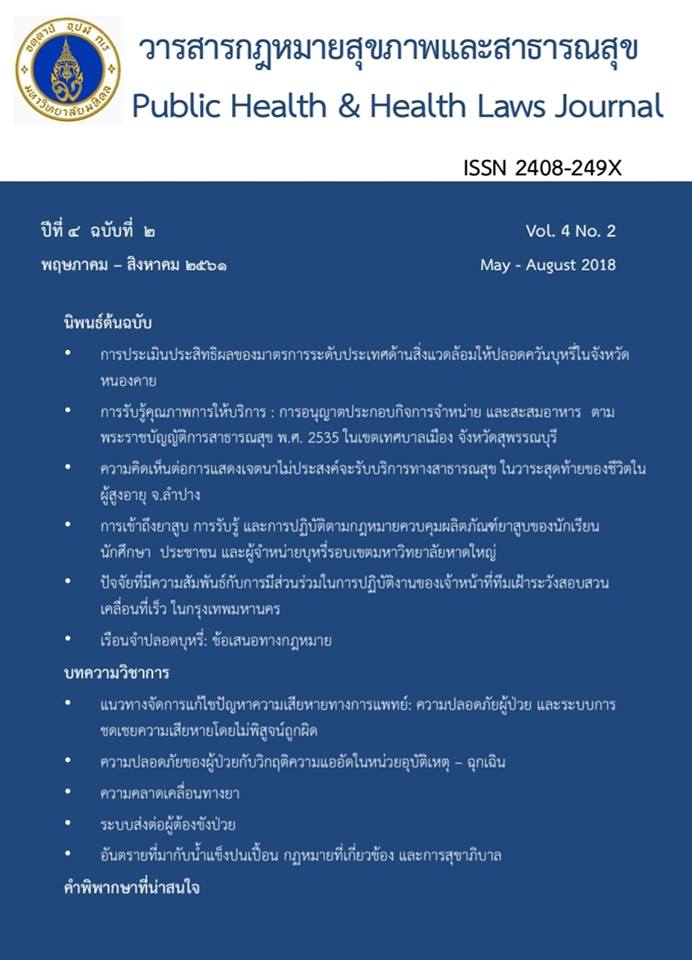Solutions to Medical Malpractice Problems: Patient Safety and the No-fault Compensation System
Abstract
Patient safety is an important issue for medical personnel. Nursing home must be aware of and responsible for all procedures of delivering services to medical service users. Hospital Accreditation Institute indicates that Patient Safety Goal emphasizes on Safety Surgery, Infection Control, Medication Safety, Patient Care Process, Line, Tube & Catheter, and Emergency Response. It is possible that undesired events may occur while providing medical services, together with the high expectation of patients for medical services, these will lead to patients’ not satisfy to the medical service and conflict with medical services’ providers. When the feeling of injustice occurred on the patients’ part, this will lead to medical litigation, both civil and criminal cases, due to the effect of violation and breach of contract. Before a lawsuit is filed, there is a mechanism for damage compensation to the patients or the family, from the medical treatment process. Countries with such systems are Sweden, Denmark, United States of America, Canada, New Zealand, as well as Thailand. The mechanism for medical damage compensation provides basic relief to mitigate the damage without proving who is at fault. The method for compensation considerations has various details. This article will help to understand the concept of patient safety and the treatment of those who have been damaged by the medical process.
References
รัตนสิทธิ์ ทิพวงศ์ และคณะ (2552). ระบบชดเชยภาวะไม่พึงประสงค์จากการบริการสุขภาพของประเทศไทยที่ควรจะเป็น: กรณีศึกษาจากปรากฏการณ์ของโรงพยาบาลร่อนพิบูล รายงานวิจัย. นนทบุรี: สำนักวิจัยระบบสาธารณสุข.
รัศมี ตันศิริสิทธิกุล และคณะ (2555). รายงานทบทวนองค์ความรู้ เรื่อง การพัฒนาระบบเพื่อความปลอดภัยของผู้ป่วย (Patient Safety). [Online], available from
http://www.shi.or.th/ เข้าถึงวันที่ 25 กันยายน, 2560.
ลือชัย ศรีเงินยวง (2553). ประสบการณ์ต่างแดน : ระบบชดเชยความเสียหายจากการรับบริการสารณสุข : บทวิเคราะห์และผลการทบทวนประสบการณ์ใน 6 ประเทศ. นนทบุรี: สถาบันวิจัยระบบสาธารณสุข.
วิฑูรย์ อึ้งประพันธ์ (2546). ความรับผิดของผู้ประกอบวิชาชีพด้านการแพทย์และสาธารณสุข. กรุงเทพฯ: วิญญูชน.
สรรธวัช อัศวเรืองชัย (2546). บทความทบทวนทางวิชาการ: ความปลอดภัยของผู้ป่วย ใน Patient Safety : Concept and Practices. นนทบุรี: สถาบันพัฒนาและรับรองคุณภาพโรงพยาบาล (พรพ.) .
สถาบันพัฒนาและรับรองคุณภาพโรงพยาบาล (2546). ยุทธศาสตร์เรื่องความปลอดภัยสำหรับผู้ป่วย ใน Patient Safety : Concept and Practices. นนทบุรี: สถาบันพัฒนาและรับรองคุณภาพโรงพยาบาล (พรพ.) .
สถาบันพัฒนาและรับรองคุณภาพโรงพยาบาล (2551). Patient Safety Goals : SIMPLE. นนทบุรี: สถาบันพัฒนาและรับรองคุณภาพโรงพยาบาล (พรพ.).
แสวง บุญเฉลิมวิภาส (2555). เอกสารประกอบการบรรยายสัมมนาการป้องกันความเสี่ยงจากการถูกฟ้องร้องวิธีการไกล่เกลี่ยข้อพิพาทและร่าง พ.ร.บ.คุ้มครอง ผู้เสียหายจากการรับบริการสาธารณสุข พ.ศ. .... .
แสวง บุญเฉลิมวิภาส (2546). กฎหมายและข้อควรระวังของผู้ประกอบวิชาชีพแพทย์และพยาบาล. กรุงเทพฯ: วิญญูชน.
สำนักงานหลักประกันสุขภาพแห่งชาติ (2550). คู่มือการดำเนินงานจ่ายเงินช่วยเหลือเบื้องต้น. กรุงเทพฯ: สำนักกฎหมาย สำนักงานหลักประกันสุขภาพแห่งชาติ.
อนุชา กาศลังกา (2556). การศึกษาปัญหาแพทย์และบุคลากรทางการแพทย์ สังกัดกระทรวงสาธารณสุขและสำนักงานปลัดกระทรวงสาธารณสุขถูกฟ้องเนื่องจากการรักษาพยาบาล. วารสารวิชาการกรมสนับสนุนบริการสุขภาพ ปีที่ 9 ฉบับที่ 1 ตุลาคม 2555 - มกราคม 2556 เล่มที่ 32: 57-69.
Accreditation Canada. Patient Safety. [cited 2010 Jan 5]; Available from: URL:
http://www.accreditation.ca/knowledge-exchange/patient-safety
Brennan TA Hebert LE, Laird NM, et al. (1991). Hospital characteristics associated with adverse events and substandard care. JAMA; 265: 3265-9.
Committee on Quality of Health Care in America, Institute of Medicine (1999). To Err Is Human: Building a Safer Health System. National Academy Press: Available from: www.books.nap.edu/html/to_err_is_human/
Emanuel L, Berwick D, Conway J, Combes J, Hatlie M, Leape L. What exactly is patient safety? [cited 2011 July 30]; Available from: URL:http://www.ahrq.gov/downloads/pub/advances2/vol1/advanceemanuel-
berwick_110.pdf
WHO. (2009). Conceptual framework for the international classification for patient safety version 1.1 : Technical Report. Geneva.
Downloads
Published
How to Cite
Issue
Section
License
Disclaimer and Copyright Notice
The content and information presented in articles published in the Journal of Law and Public Health Policy represent the opinions and sole responsibility of the respective authors. The editorial board does not necessarily agree with or assume any responsibility for the views expressed.
All articles, data, content, images, and other materials published in the Journal of Law and Public Health Policy are the intellectual property of the journal. Any individual or organization wishing to reproduce, distribute, or otherwise use the entirety or any part of such materials must provide proper citation.





